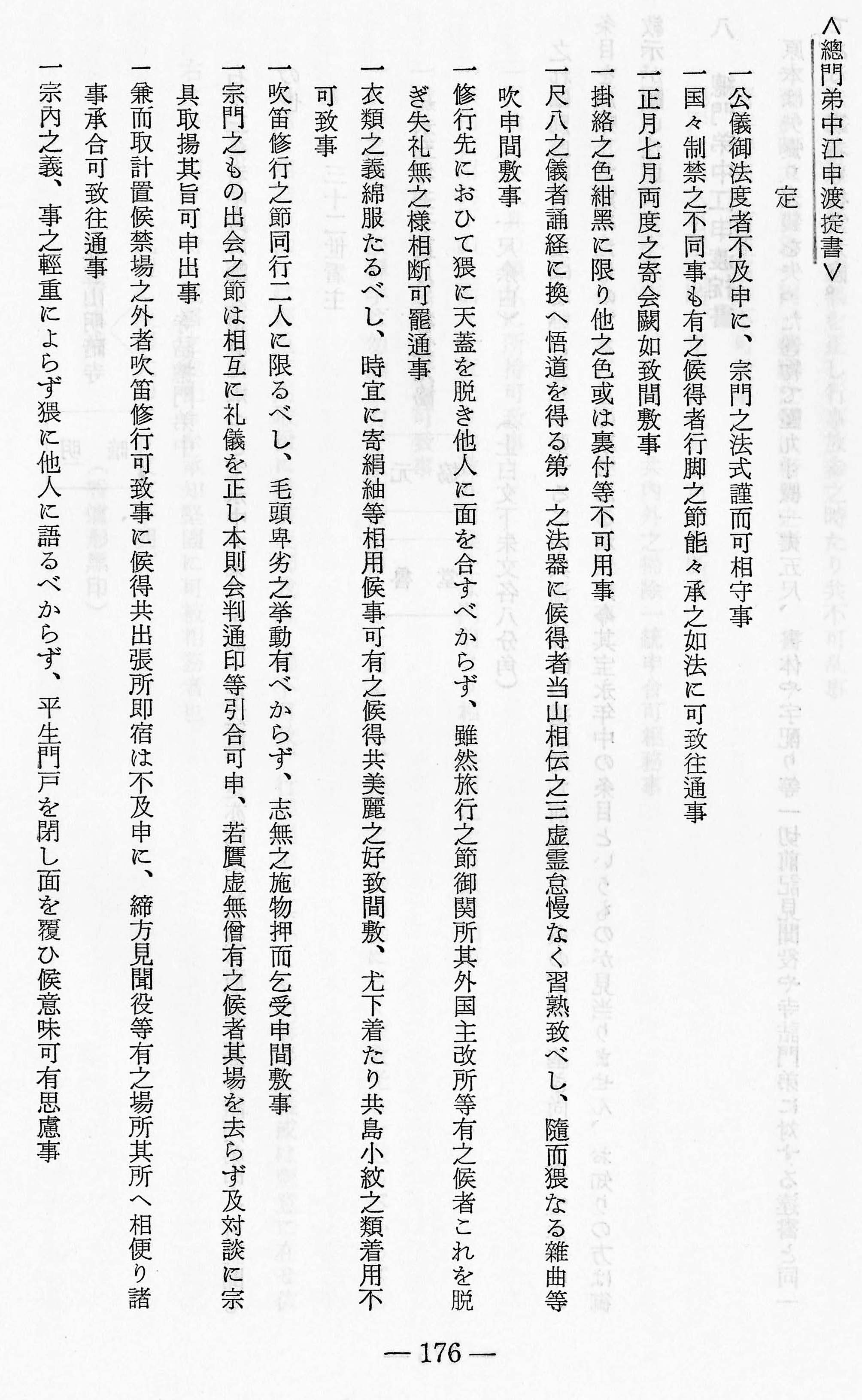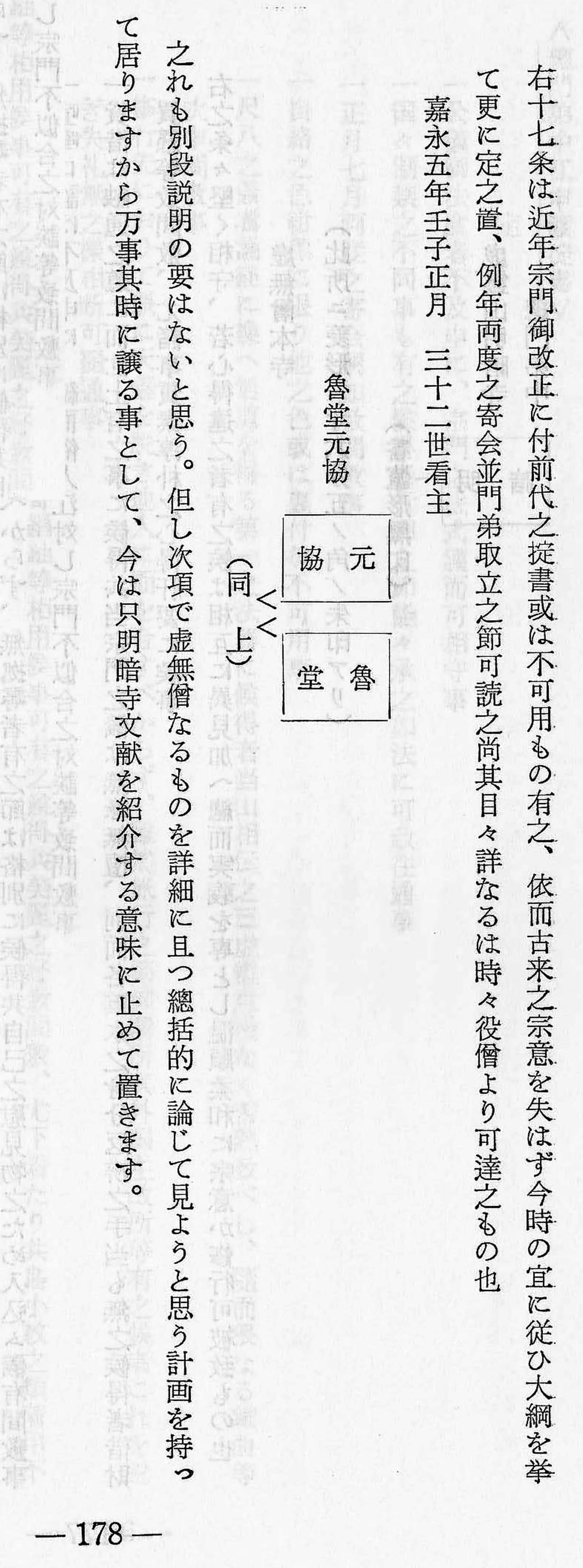|
1852: Kyōto Myōan-ji's 32nd 'Kansu' Rodō Genkyō's
Commandments Regarding 'Komusō' Begging Practice
and 'Sui-teki shugyō' - and the Possible Origin
of the Now so Very Misused Term 'Suizen'?
Web page last updated on August 27, 2024.
魯堂元協 - RODŌ GENKYŌ, died in 1859
吹笛修行 - SUI-TEKI SHUGYŌ
"To Blow a Flute Ascetic Practice"
Links to closely related webpages:
"1950s ... : The Origin of 'Suizen' at Kyōto Myōan-ji:
Kobayashi Shizan, Tomimori Kyozan,
Tanikita Muchiku, Yasuda Tenzan,
Hirazumi Taizan, Koizumi Ryōan,
Fukumoto Kyoan, Yoshimura Sōshin a.o."
1974 ...: Untruthful 'Suizen' & "Shakuhachi Meditation"
Information & Assertions, East & West
- Presented in Western Languages, Primarily
In 2000, Prof. Tsukitani Tsuneko at Ōsaka University declared in her impressive and authoritative scholarly publication about classical shakuhachi honkyoku
that she could not decide when eventually the practice of "shakuhachi asceticism" came to be referred to as 'Sui-zen',
吹禅,
"to play/blow a flute as meditation", so to speak.

The late professor Tsukitani Tsuneko's comments about 'sui-teki shugyō'
and the possible origin of the term 'suizen'. Tsukitani 2000, p. 172, note 138.
The ORIGIN of 'SUIZEN', acc. to TSUKITANI TSUNEKO?
「しかし、「坐禅」にかわる尺八修行の意味でいずから「吹禅」
というようになかったか、その典拠を未だ見つける事ができない。」
"However, I have yet to find any source as to when [how?] the term 'Suizen' came to mean shakuhachi training in place of 'Zazen'."
The irrefutable fact is that 'Sui-zen' was never featured in any Edo Period text as a description of ascetic shakuhachi practice, at all. Period!
Quite certainly acc. to Kiku Day and certainly shown on the ESS website, chapter "Shakuhachi Terms", 2007:
“Suizen
(吹禅) – Lit: Blowing Zen. The act of playing the shakuhachi as an act of meditation.
Although widely used, this word is, according to Tsukitani Tsuneko (conversation, 2007), a post-Edo period creation.”
Source: https://shakuhachisociety.eu/shakuhachi/glossary/
Acc. to Christian Theodore Mau, 2014:
"As surprising as it may sound to those already familiar with the expression, however,
the word's coinage is less than a century old, thus often rendering its usage somewhat anachronistic
when applying it in connection with pre-20th century practice."
Source: https://eprints.soas.ac.uk/18260/
Finally, to put matters absolutely straight and clear:
The term 'Sui-zen' is neither to be found featured in any text dating from Meiji and Taishō times, 1868-1926, neither,
nor even appearing in any (publicly accessible) form during the entire Shōwa period, 1926-1989, until and before the year 1950, or very soon thereafter.



Kyōto Myōan-ji's 32nd 'Kansu', supervisor, Rodō Genkyō's commandments
regarding komusō begging practice and 'sui-teki shugyō'. Nakatsuka 1979, pp. 176-178.
Initially, there are two statements that stand out in Genkyō's 1852 document, namely:
Par. 5:
尺八之儀者
誦経に換え
悟道を得る
第一の法器に
候得者
当山相伝之
三虚霊怠慢なく
習熟致べし。
'Shakuhachi no gi wa,
jukyō ni kae
godō wo eru
dai-ichi no hōki ni
sōrō e(ru) mono
tōzan sōden no
San-kyorei taiman naku
jūjuku itasu beshi.'
"As for the shakuhachi,
that is the foremost tool
with which to attain enlightenment,
instead of the recital of sutras,
and one must acquire proficiency
in this temple's inherited 'San-kyorei'
with no carelessness, at all."
'San-kyorei', 三虚霊,
the "Three 'Non-Dual Spirit(s)'" are the 3 legendary, classical 'kyoku', titled 'Kyorei', 'Kokū' and 'Mukaiji',
now quite often being referred to as 'San-koten honkyoku',
三古典本曲.
Par. 8:
吹笛修行之節
同行二人限るべし。
'Sui-teki shugyō no setsu
dōgyō futari kagiru beshi.'
"In times of practicing 'blowing a flute asceticism',
the number of travelling fellow pilgrims shall be limited to (only) 2."
Do note, that nowhere in this document of Genkyō's do you find any reference to any practice of actual "shakuhachi meditation".
It was, indeed, as late as in 1950, that the new term 'Sui-zen' was invented, introduced and spread, more specifically by the first abbot of the then newly established Kyōto
Myōan Temple, namely the prominent Tōfuku-ji Zen monk Yasuda Tenzan.
Already before then, however - in 1930 - two outstanding representatives of the Myōan Taizan-ha shakuhachi tradition, Kobayashi Shizan and Tomimori Kyozan,
certainly took an intermediate ideological "step forward" from Genkyō's 'sui-teki shugyō" when they announced their new term 'sui-shō-zen',
吹簫禅, "to play a flute meditation", in a co-authored book of theirs about the 'Myōan' Way of the Shakuhachi.
Still, it was only as late as after 1950, when the new Myōan-ji was inaugurated in Kyōto, and the Zen master Yasuda Tenzan had taken the seat at that temple's first Buddhist monk and abbot in residence, that the term 'Suizen' was defined and initially spread within the narrow ascetic shakuhachi circles, those of the Myōan Taizan-ha, established by Higuchi Taizan around 60 years earlier.
Then, in 1974, Columbia Records in Japan released the triple-LP set 'Suizen', KX-7001-03, with comphensive sleeve notes written by the music historian Kamisangō Yūkō.
Here, on page 17 in the pamphlet, Kamisangō claimed, completely unsubstantiated by any source document, that there were 'komusō',
虚無僧,
in existence and action as early as in 1614, and also that the real 'komusō' who eventually took over from the last 'komosō'
during the 1630-1640s did practice 'suizen', which is absolutely false: No preserved evidence exists, whatsoever.
Later, both Tsukitani, Seyama & Simura, 1994*, and Simura, 2002**, have referred to 'komusō' practices during the Edo Period, as if they practiced 'suizen' - which is simply not true.
There is in fact not even any written proof at all that 'komusō' performed anything like "shakuhachi meditation" prior to the 19th century,
simple as that!
*)
"It was not so easy to become a member of the Fuke sect or a komusō.
This was due to the arrangement of the system of rules as determined by the
Tokugawa shogunate. Accordingly, it can be said that the shakuhachi has been
handed down to us within a limited, chartered organisation.
That organization maintained an ideology centred around Zen Buddhism. Moreover, Zen in the
Fuke sect was nothing but the playing of the shakuhachi.
This ideology and lifestyle was called suizen ('blowing Zen').
Thus, in terms of suizen, the shakuhachi was not a musical instrument, and naturally pieces performed on it were not
considered as being music. To them, the shakuhachi was a hōki ('religious
instrument'), that is to say, a sacred tool for the purpose of spiritual training."
Source:
Tsukitani Tsuneko, Seyama Tōru & Simura Satosi:
'The Shakuhachi: The Instrument and its Music,
Change and Diversification.'
In: 'Contemporary Music Review', 1994, Vol. 8, Issue 2, p. 111.
Translated by Riley Kelly Lee.
**)
"The huke syakuhati developed in the Huke subsect of Rinzai-sect Zen during the Edo period (1600-1867). It was used in Buddhist services for suizen 'blowing Zen', a meditative activity comparable to zazen 'sitting Zen' (Sanford 1977)."
Now, sad to say, James H. Sanford certainly did not mention 'suizen' in his significant 1977 article, just as the so called "Fuke Sect" should never have been described in any way as a "subsect of Rinzai-sect Zen", at all.
Source: The Garland Encyclopedia of World Music.
Vol. 7, Routledge, 2002, p. 702.
|
吹
笛
修
行
|




